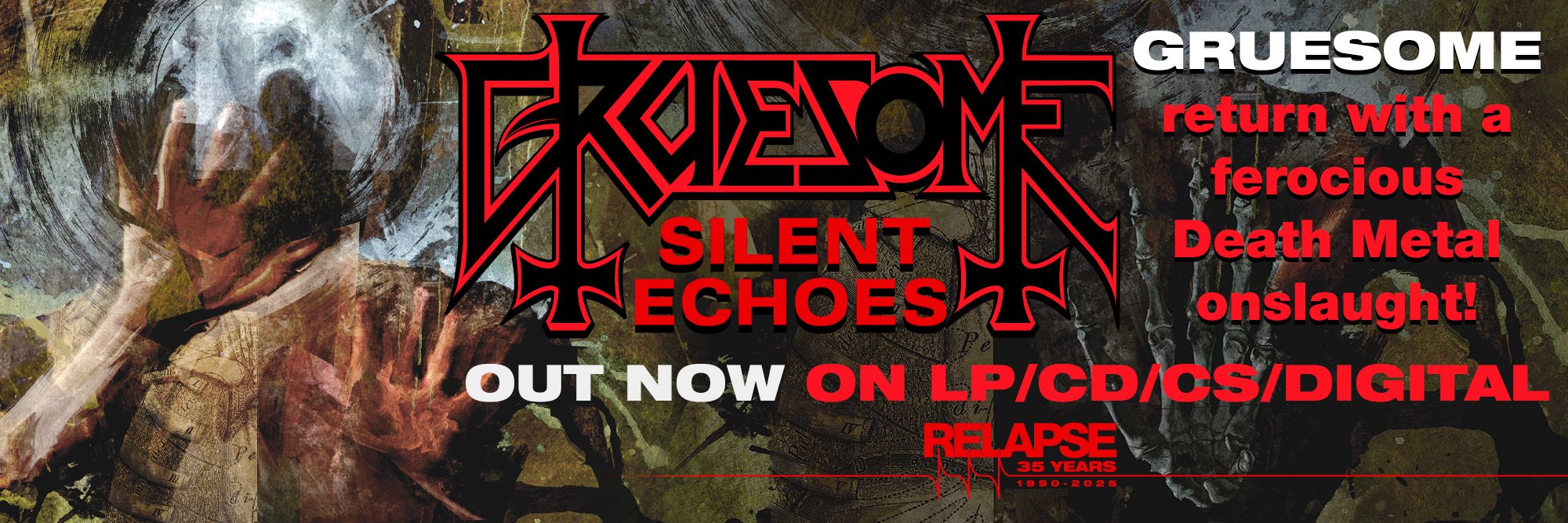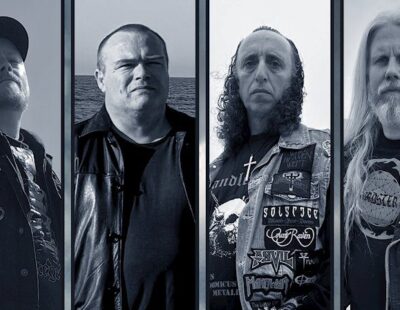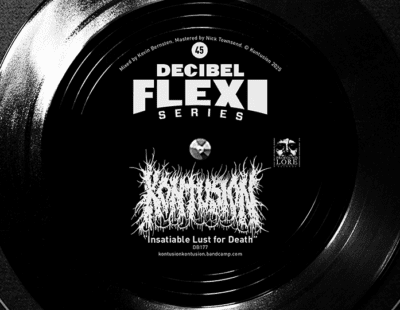
Decibel have been long-time admirers (HERE) of Swedish musician Jari Lindholm’s work. First, in one-album stunner Slumber. Next, from Slumber’s ashes in AtomA. And finally in Enshine, Lindholm’s melodic death metal project with Fractal Gates/Cold Insight’s Sebastien Pierre. Parallel to all that, the Swedish songmaster has had his beautiful compositional/playing style imbued in Sears of Years, a breathtakingly good post-rock outfit more known in China than in Chicago. Well, between the years, bands, and other duties, Lindholm also formed Exgenesis with Alejandro Lotero, formerly of multi-national outfit Aeonian Sorrow.
Musically, Exgenesis are old-school Katatonia imbued with a heavy funeral doom element, but the distinction comes with Lindholm’s playing style. He’s a legato player, similar in form to Rapture’s lead axe-man Tomi Ullgrén. Across Exgenesis’ catalog, the Swede crafts some of the most heartbreakingly smooth harmonies that are often smashed with absolute heaviness. There’s an otherworldly loneliness to the way Lindholm creates. All of this can be heard in the opening track, “Hallowness,” to Exgenesis’ new album, Solve et Coagula. Elsewhere, there’s a sense of foreboding at play. Like on “Where the Hope Ends,” “Truth,” and “Intracosmos.” Exgenesis isn’t just Lindholm’s signature, however. Joining the Swede, is Colombian vocalist/guitarist Lotero, whose vocals impart nuance, power, and intensity. He’s like Dan Swanö, Tobias Netzell, and Henri Villberg in one. On Solve et Coagula, the Medellín native gives his all — check out “Embers,” “Stasis,” and “Coagula.”
We found Lindholm and bandmate Lotero at opposite ends of the earth but ready to discuss Exgenesis’ new album, Solve et Coagula, and its immolative musical and lyrical directive.
So, Jari, you’re Swedish and Alejandro, you’re Colombian. How’d did you two meet?
Jari: We had known each other online for a few years already when the idea of Exgenesis came about, just talking about music or everyday stuff. And sometimes this can lead to a collaboration like what we do when similar ideas are shared.
Alejandro: We became friends online, sharing music and talking about everyday things, the idea of making music together came up sharing some of our unreleased work. Once we started to work together it was very fluent and with a good rhythm sometimes. With the time zone differences it was quite hard to sync, but after the first EP came out it was worth the wait and the work.
Jari’s history as a guitarist is documented and well-known in certain circles. Fans of Slumber, Enshine, Atoma, among others. Who are some of your primary influences? Your legato style suits your melancholic approach.
Jari: I learned to play, at least metal in particular first with the help of some tab books, especially Megadeth’s Countdown to Extinction. Then, after that, I started figuring out songs by ear (or at least trying to), like The Somberlain by Dissection, for example. Later, discovering Opeth and their use of more complex chords with full-on metal distortion, that’s something that I’ve been using a lot. Some of that early stuff like Slumber feels a bit like a crossing of old Katatonia and Dimmu Borgir if I listen to it now. We had a lot of black metal influence and background actually, especially the symphonic stuff but then merged that with that simple rock beat a la Brave Murder Day, etc. Oh, and I would have to also mention Novembre and Tiamat.
Alejandro, your vocals on Aeonian Sorrow are a bit different from what you’re doing on Exgenesis. How would you describe your vocal style on Solve et Coagula? There’s brutality but also a lot of emotive value in your growls and screams.
Alejandro: For Aeonian Sorrow, it was a more arrangement-like job. The idea was of a more deep voice-work to contrast the other voices on the record, but for Exgenesis I’m pretty much free to play with contrasts and vocal nuances, and of course the lyric writing helps to transmit all of the concept and feeling that I want to do with my voice, and this is the result of that.
Jari, you have recently enlisted drummer Christian Netzell (Vholdghast, ex-In Mourning). What prompted the need for a real drummer on Solve et Coagula?
Jari: Well, if there is a chance to have real drums, I don’t see any reason not to do it, really. The programmed drums, like the ones we used on the EP, are often the result of necessity, as when you are working on a project alone, for example. On the other hand, on the EP that became a part of that release’s sound, so I wouldn’t want to change that either. Nowadays, I can hardly stand programming drums anymore because the programming itself bores me to death. I try to work with real drums whenever possible.
Jari: I was fully occupied with Seas of Years for a long time, as we had the opportunity to tour China, which we did twice. There is a whole lot of preparation for such a thing, not only the rehearsals and the whole musical bit, but organizing it all was quite a task too. And besides that, we did one album and one EP in conjunction with those two tours respectively, which I also produced myself, so my metal projects had to be on a bit of hiatus during that time.
Alejandro: I was living and studying in New Zealand. It was a very exciting chapter of my life. I took a break from making music during this period and all the experiences gathered through these years were part of the material to conceptualize Solve et Coagula.
Some of the songs feel ominous, like the opening for “Hollowness,” “Where the Hope Ends,” and “Truth,” while others have a brief glint of hope, such as “Solve,” “Coagula,” and “Stasis.” Was there a theme—loss to hope—to the songwriting sessions?
Jari: I think the core is always that ominous side, but then some other ideas came into the picture, and they needed to be accompanied by counterparts here and there, so, in the end, maybe a third of the album ended up being a little less dark. It’s maybe not a very planned thing from the start, but I always try to find different ways of adding a bit of variation to an album.
Alejandro: As the very concept of the album is some kind of duality, those feelings make the album more dynamic. “Telling a story” from beginning to end.
What songs are currently speaking to you two?
Jari: From the album, probably “Stasis” and “Embers” are my favorites right now.
Alejandro: I like “Stasis” and “Coagula” a lot. They’re very good examples of our work and will.
The title, Solve et Coagula, is Latin for ‘dissolve and coagulate.’ What is the idea behind the title?
Alejandro: This is an alchemical concept that pictures the process of a real transformation/creation by sacrificing to get anything in exchange. It’s like if you want to get a newer version of yourself or something, you must destroy your old version. I really liked that concept for the album because the EP concept was the darkness (aphotic), the one we have inside and outside. To find ourselves and see what lies beyond, but Solve et Coagula is about the fire; evolving and creating by leaving behind bonds and destroying ourselves. There’s also some “Easter Eggs” that I placed in the lyrics regarding popular culture and other subjects that I like, and that had a mark on my personal life.
What are some of the topics you’re covering? I sense hopelessness, anger, and introspection.
Alejandro: Yes, indeed. I took fire as main concept, the fire that destroys and the fire that creates. I took inspiration in the Dante’s Inferno, old myths, and personal experiences to create a journey from the absence of fire, to the burning of oneself. Topics like introspection, suicide, self-realization, anger, and hope are carried throughout the lyrics.
I gather a lot of the recording took place over 2019. What were some of the highlights of the process?
Jari: Yes, that’s right. It was a pretty interesting process, especially traveling to Norway to rehearse and then the drum recording here in Stockholm. The rest of it for me, guitars, bass, mixing, etc. was done in my studio, which is located in my home, so that was pretty much like what I do all the time anyway.
Alejandro: Usually, vocals are the last part to be recorded. I did it here in Medellin at my friend’s Leo Sierra Studio. It took about two months, and it was pretty fun and important to me to be back in the studio doing what I love.
Alejandro: I’ve made the art direction using the base concept, as I’ve mentioned before. I got inspiration from alchemical symbols and rituals. You can see parts of the ouroboros and fire as main roles. We had several meetings about how all this material could be translated to the piece of art that Katell made.
The album’s recently released on Rain Without End Records. A little irony in that Exgenesis has an October Tide feel. I’m sure people have asked about that connection. On purpose or more coincidence?
Jari: Well, the label has that kind of direction, so it’s hardly a coincidence that way I think. I’ve never asked Robert about the choice of name, but it’s pretty easy to tell what it represents, if you are into this whole style of music.
What are your plans next? Album’s out. Any possibilities of seeing Exgenesis on tour?
Jari: Right now, it’s pretty hard to say, especially with the whole COVID-19 situation. It seems we are stuck on different continents for some time. And even without that, arranging gigs can be a bit of challenge with this distance. So we’ll have to wait and see, or maybe the next you’ll hear from us will be in recorded form.
Alejandro: I personally would love to be on tour with Exgenesis, but the situation is also hard when we live so far from each other. I talked with Jari many times about this in the past, trying to be creative and find a way to do it, but you know, we have our jobs, distance and other things that are very hard to sync to make it possible.
** Exgenesis’ new album, Solve et Coagula, is out now on Rain Without End/Naturmacht. Order the CD direct from Exgenesis (HERE) or from Rain Without End/Naturmacht (HERE). NOTE: Exgenesis’ debut EP, Aphotic Veil, is also available again. Use either link to order!






